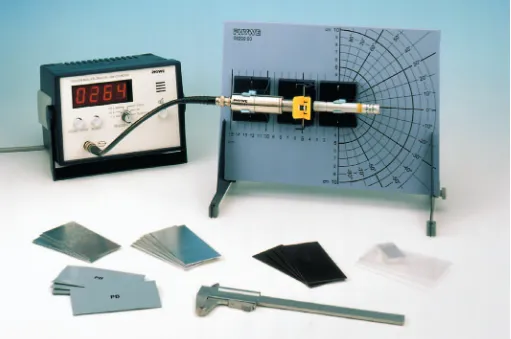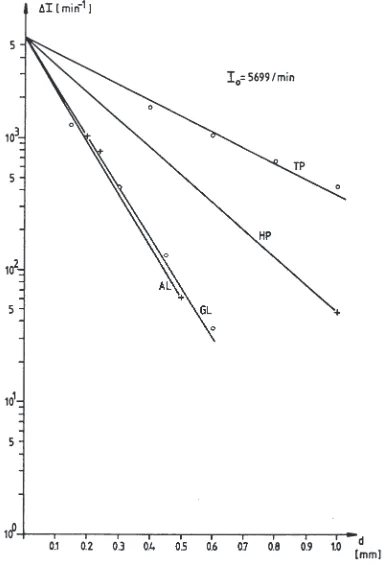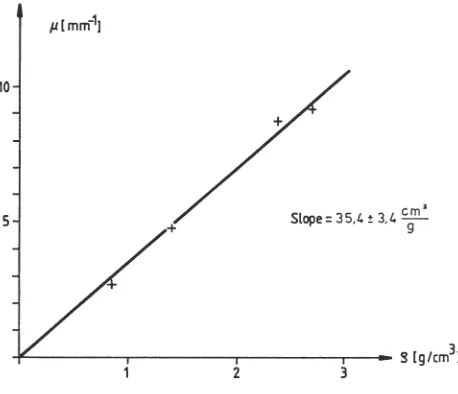223 PHYWE Systeme GmbH &Co. KG · D - 37070 Göttingen Laboratory Experiments Physics
Radioactivity
Physical Structure of Matter
Electron absorption 5.2.31-00
Principle:
The attenuation of an electron parti-cle stream passing through a materi-al layer depends both on the thick-ness of the layer and on the mass coverage, resp. the “mass per unit area”. It will be shown that the parti-cle flux consisting of electrons of a particular energy distribution de-creases with the “mass per unit area”. As electron source, a radioactive sample of Sr90is used.
Tasks:
1. The -counting rates are meas-ured as a function of the absorber thickness using different absorb-ing materials such as aluminium (AL), glass (GL), hard paper (HP), and typing paper (TP).
Counting rate Ias a function of absorber thickness.
2. The attenuation coefficients are evaluated for the four absorbing materials and plotted as a func-tion of the density.
Radioactive source, Sr-90, 74 kBq 09047.53 1
Geiger-Müller Counter 13606.99 1
Counter tube, type A, BNC 09025.11 1 Screened cable, BNC, l= 750 mm 07542.11 1
Stopwatch, digital, 1/100 sec. 03071.01 1 Base plate for radioactivity 09200.00 1 Supports f. base 09200.00, 2 pcs 09200.01 1 Counter tube holder on fix. magn. 09201.00 1 Plate holder on fixing magnet 09203.00 1 Source holder on fixing magnet 09202.00 1
Vernier caliper 03010.00 1
Absorption plates f. beta-rays 09024.00 1 Cover glasses 22⫻40 mm, 50 p 64688.00 1
What you need:
Complete Equipment Set, Manual on CD-ROM included
Electron absorption
P2523100
What you can learn about …
Related topics
Density, counter tube, radioactive decay, attenuation coefficient, mass coverage.
Principle
The attenuation of an electron particle stream passing through a material layer depends both on the thickness of the layer and on the mass coverage, resp. the “mass per unit area”. It will be shown that the particle flux consisting of electrons of a parti-cular energy distribution decreases with the “mass per unit area”. As electron source, a radioactive sample of Sr90is used.
Equipment
Radioactive source, Sr-90, 74 kBq 09047.53 1
Geiger-Müller Counter 13606.99 1
Counter tube, type A, BNC 09025.11 1
Screened cable, BNC, l= 750 mm 07542.11 1
Stopwatch, digital, 1/100 sec. 03071.01 1
Base plate for radioactivity 09200.00 1
Supports f. base 09200.00, 2 pcs 09200.01 1
Counter tube holder on fix. magn. 09201.00 1
Plate holder on fixing magnet 09203.00 1
Source holder on fixing magnet 09202.00 1
Vernier caliper 03010.00 1
Absorption plates f. beta-rays 09024.00 1
Cover glasses 22 x 40 mm, 50 p 64688.00 1
Tasks
1. The b-counting rates are measured as a function of the absorber thickness using different absorbing materials such as aluminium (AL), glass (GL), hard paper (HP), and typing paper (TP).
2. The attenuation coefficients are evaluated for the four ab-sorbing materials and plotted as a function of the density.
Set-up and procedure
The experimental set-up is shown in Fig. 1. The plate holder which has a screw to fix the different absorbing materials is placed between the counter tube and the source holder. The distance between the front edge of the Sr90source and the counter tube should be about 25 mm. The plastic cover of the counter tube has to be removed. The counter tube is connect-ed to the Geiger-Müller Counter by means of a screenconnect-ed BNC-cable. The Geiger-Müller Counter is used to count and total the pulses for different time intervals.
For statistical reasons, the time interval will have to vary be-tween 60 seconds and 900 seconds.
First the counting rate is taken without an absorber. After that, the source is placed far away from the counter tube and the background radiation is measured over a period of at least 600 seconds.
5.2.31
-00
Electron absorption
25231-00 PHYWE series of publications • Laboratory Experiments • Physics • © PHYWE SYSTEME GMBH & Co. KG • D-37070 Göttingen
2
Theory and evaluation
The attenuation of an electron particle stream by an absorbing material as a result of scattering and real absorption can be checked with a counter tube. The number of particles entering through the window of the counter tube per unit time, %I, is
proportional to the counting rate indicated by the Geiger-Müller Counter. If %I0is the number of particles entering the
counter tube per unit time in the absence of absorbing mate-rial, in the presence of absorbing material of thickness d, we
expect to have, with %Ias the number of particles entering the
counter tube per unit time
%I= %I
0e-N
d
(1)
Nis the attenuation coefficient. It can be determined from Eq. (1):
(2)
Plotting %Isemilogarithmically versus dmakes it possible to measure the attenuation coefficient of the different materials used.
1. In Fig. 2 the counting rates are plotted semilogarithmically versus d. The graph consists of straight lines which proves the
validity of Eq. (1). The counting rate without an absorbing material and with a distance of 25 mm between source and counter tube was found to be 5699 [min-1]. Here and in the fol-lowing count rates, the background radiation of 21 counts/min has already been taken into account. The following values were used for the graph in Fig. 2:
d[mm] corrected count rate Material
[min-1]
0.4 1721 (Typing Paper)
0.6 1056 (Typing Paper)
0.8 672 (Typing Paper)
1.0 434 (Typing Paper)
1.0 48 (Hard Paper)
2. From the slope of the straight lines in Fig. 2, the attenuati-on coefficients can be calculated using Eq. (2). The values obtained together with the densities of the absorbing materi-als are shown in the following table:
m r
[mm-1] [g/cm3]
Typing Paper 2.71 0.852
Hard Paper 4.78 1.39
Glass 8.75 2.37
Aluminium 9.15 2.70
Fig. 3 shows the attenuation coefficient as a function of the density. The factor of proportionality between mand ris the mass attenuation coefficient mm.
mm= = 35.4 ± 3.4 (3)
For a particuluar energy distribution of the particles conside-red, e. g. for particular b-emitting source, mmis a constant for all absorbing materials. In the literature pertaining to this com-ples* mmcan be calculated using the empirical formula
Nm= Wm> 0.5 MeV
where Wm is the maximum energy of the particles. For the
electrons of Kr85, W
Using Eq. (3) we can rewrite Eq. (1) in the following way
%I= %I0e-mm·r·d (4)
or
%I= %I0e-mm·m’’ (5)
The product m’’ = r · dwithin Eq. (5) is the mass coverage,
resp. the “mass per unit area” and obviously the quantity which determines the attenuation of the particle stream when it passes through the material layer of thickness d.
* Kuchling, Taschenbuch der Physik, Verlag Harri Deutsch, Thun, Frankfurt/Main
5.2.31
-00
Electron absorption
25231-00 PHYWE series of publications • Laboratory Experiments • Physics • © PHYWE SYSTEME GMBH & Co. KG • D-37070 Göttingen


